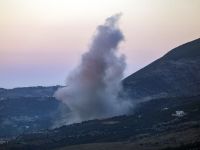In May 1998 India exploded up to five nuclear devices, following on from its first in 1974. Pakistan then followed suit. India has steadfastly refused to join in international arrangements for limiting weapons proliferation, though Pakistan has offered to do so if India would.
The nuclear weapon capabilities of both countries have arisen independently of the civil nuclear fuel cycle. Both use indigenous uranium.
Because they are outside the NPT, they are largely excluded from trade in nuclear plant or materials, which has hampered their development of civil nuclear energy.
In May 1998 India and Pakistan each exploded several nuclear devices underground. This heightened concerns regarding an arms race between them, with Pakistan involving China, an acknowledged nuclear weapons state.
India and Pakistan (with Israel) have been "threshold" countries in terms of the international non-proliferation regime, possessing, or quickly capable of assembling one or more nuclear weapons.
Their nuclear weapons capability at the technological level was recognized (all have research reactors at least) along with their military ambitions, and all remained outside the 1970 Nuclear Non-Proliferation Treaty (NPT), which 186 nations have now signed.
They are thus largely excluded from trade in nuclear plant or materials, except for safety-related devices for a few safeguarded facilities.
Both countries are opposed to the NPT as it stands, and India has consistently attacked the Treaty since its inception in 1970.
Relations between the two countries are tense and hostile, and the risks of nuclear conflict between them have long been considered quite high.
Kashmir is a prime cause of bilateral tension, its sovereignty being in dispute since 1948. There is persistent low level military conflict due to Pakistan backing a Muslim rebellion there.
Both engaged in a conventional arms race in the 1980s, including sophisticated technology and equipment capable of delivering nuclear weapons. In the 1990s the arms race quickened.
In 1994 India reversed a four-year trend of reduced allocations for defense and despite its much smaller economy, Pakistan was expected to push its own expenditures yet higher. Both have lost their patrons: India, the former USSR, and Pakistan, the United States.
But it is the growth and modernization of China's nuclear arsenal and its assistance with Pakistan's nuclear power programme and, reportedly, with missile technology, which exacerbate Indian concerns.
In particular, Pakistan is aided by China's People's Liberation Army, which operates somewhat autonomously within that country as an exporter of military material.
India: Nuclear power for civil use is well established in India. Its civil nuclear strategy has been directed towards complete independence in the nuclear fuel cycle, necessary because of its outspoken rejection of the NPT.
This self-sufficiency extends from uranium exploration and mining through fuel fabrication, heavy water production, reactor design and construction, to reprocessing and waste management.
It has a small fast breeder reactor and is planning a much larger one. It is also developing technology to utilize its abundant resources of thorium as a nuclear fuel.
It has 14 small nuclear power reactors in commercial operation, two larger ones under construction and ten more planned. The 14 operating ones comprise:
two 150 MWe BWRs from USA, which started up in 1969, now use locally-enriched uranium and are under safeguards, two small Canadian PHWRs (1972 & 1980), also under safeguards, and ten local PHWRs based on Canadian designs, two of 150 and eight 200 MWe.
The two under construction and two of the planned ones are the larger (450 MWe) versions of these 200 MWe domestic products. Construction has been seriously delayed by financial and technical problems.
Since the tests Russia has reaffirmed its intention to supply the country's first large nuclear power plant, comprising two VVER-1000 reactors, under a Russian-financed US$ 3 billion contract.
Nuclear power supplied 2.65 percent of India's electricity in 1999 and this is expected to reach 10 percent by 2005. Its industry is largely without IAEA safeguards, though a few plants (see above) are under facility-specific safeguards.
As a result India's nuclear power program proceeds largely without fuel or technological assistance from other countries.
Its power reactors have been among the worst-performing in the world (re capacity factors), reflecting the technical difficulties of the country's isolation, but are apparently now improving significantly.
Its weapons material appears to come from a Canadian-designed 40MW "research" reactor which started up in 1960 (well before the NPT), and a 100MW indigenous unit in operation since 1985, both using local uranium (India does not import any nuclear fuel).
It is estimated that India may have built up enough weapons-grade plutonium for a hundred nuclear warheads.
The country has at least three other research reactors including the tiny one which is exploring the use of thorium as a nuclear fuel, by breeding fissile U-233. In addition, an advanced heavy-water thorium cycle is under development.
India exploded a nuclear device in 1974 which it has consistently claimed was for peaceful purposes. Others saw it as a response to China's nuclear weapons capability.
It was then universally perceived, notwithstanding official denials, to possess, or to be able to quickly assemble, nuclear weapons.
In 1997 it deployed its own medium-range missile and is now developing a long-range missile capable of reaching targets in China's industrial heartland.
In 1995 the USA quietly intervened to head off a proposed nuclear test. The latest tests are unambiguously military, including one claimed to be of a sophisticated thermonuclear device, and their declared purpose is "to help in the design of nuclear weapons of different yields and different delivery systems".
Indian security policies are driven by: its determination to be recognised as the dominant power in the region; its increasing concern with China's expanding nuclear weapons and missile delivery programs; and its obsession with Pakistan, with its presumed nuclear weapons capability and now the clear capability to deliver such weapons deep into India.
It perceives nuclear weapons as a cost-effective political counter to China's nuclear and conventional weaponry, and the effects of its nuclear weapons policy in provoking Pakistan is, by some accounts, considered incidental.
India has had an unhappy relationship with China. Soundly defeated by China in the 1962 war, relations were frozen until 1998.
Since then a degree of high-level contact has been established and a few elementary confidence-building measures put in place.
China still occupies some Indian territory. Its nuclear weapon and missile support for Pakistan however is currently a major bone of contention.
Pakistan: In Pakistan, nuclear power is insignificant in terms of total energy production and requirements, supplying only 0.65 percent of the country's electricity.
It has one small (125 MWe) Canadian PHWR nuclear power reactor from 1971 which is under international safeguards, and a 300 MWe PWR supplied by China under safeguards, which started up in May 2000. A third one, a Chinese PWR, is planned. Enriched fuel for the PWRs will be imported from China.
It also has a 9 MW research reactor of 1965 vintage, and despite denials there are persistent reports of another "multipurpose" reactor, a 50 MW PHWR near Khushab, which is presumed to have potential for producing weapons plutonium.
Pakistan's concentration is on weapons technology, particularly the production of highly enriched uranium suitable for nuclear weapons, utilizing indigenous uranium. It has at least one small centrifuge enrichment plant.
In 1990 the US Administration cut off aid because it was unable to certify that Pakistan was not pursuing a policy of manufacturing nuclear weapons.
In 1996 USA froze export loans to China because it was allegedly supplying centrifuge enrichment technology to Pakistan. Indian opinion is in no doubt about Pakistan's nuclear weapons capability.
Pakistan has made it clear since early 1996 that if India staged a nuclear test, it had done the basic development work and would immediately start assembling its own nuclear explosive device. It is assumed to now have enough highly-enriched uranium for up to 40 nuclear warheads.
In April 1998 Pakistan test fired a long-range missile capable of reaching Madras in southern India, pushing home the point by naming it after a 12th Century Muslim conqueror. This development removed India's main military advantage over Pakistan.
Pakistan's security concerns derive from India's possession of a nuclear weapons capability, its development of short and intermediate-range missiles and, since their partition in 1947, its defeat by India in two of three wars, notably in East Bengal, now Bangladesh.
Nuclear arms control in the region: The public stance of the two states on non-proliferation differs markedly. If anything, Pakistan appears to have dominated a continuing propaganda debate.
Pakistan has initiated a series of regional security proposals. It has repeatedly proposed a nuclear free zone in South Asia and has proclaimed its willingness to engage in nuclear disarmament and to sign the Non-Proliferation Treaty if India would do so.
It has endorsed a United States proposal for a regional five power conference to consider non-proliferation in South Asia.
India has taken the view that solutions to regional security issues should be found at the international rather than the regional level, since its chief concern is with China. It therefore rejects Pakistan's proposals.
Instead, the 'Gandhi Plan', put forward in 1988, proposed the revision of the Non-Proliferation Treaty, which it regards correctly as inherently discriminatory in favor of the nuclear-weapon States, and a timetable for complete nuclear weapons disarmament.
It endorsed early proposals for a Comprehensive Test Ban Treaty and for an international convention to ban the production of highly enriched uranium and plutonium for weapons purposes, known as the 'cut-off' convention.
The United States has, for some years, and more vigorously under the Clinton administration, pursued a variety of initiatives to persuade India and Pakistan to abandon their nuclear weapons programs and to accept comprehensive international safeguards on all their nuclear activities.
To this end the Clinton administration has proposed a conference of nine states, comprising the five nuclear-weapon States, Japan, Germany, India and Pakistan.
This and previous similar proposals have been spurned by Indian observers. India countered with demands that other potential weapons states, such as Iran and North Korea, should be invited, and that regional limitations would only be acceptable if they were accepted equally by China.
The USA would not accept the participation of Iran and North Korea and such initiatives have lapsed.
Another, more recent approach, centers on the concept of containment, designed to 'cap' the production of fissile material for weapons purposes, which would hopefully be followed by 'roll back'.
To this end India and the United States jointly sponsored a UN General Assembly resolution in 1993 calling for negotiations for a 'cut-off' convention.
Should India and Pakistan join such a convention, they would have to agree to halt the production of fissile materials for weapons and to accept international verification on their relevant nuclear facilities (enrichment and reprocessing plants).
In short, their weapons programs would be thus 'capped'. It appears that India is now prepared to join negotiations regarding such a Cut-off Treaty, under the UN Conference on Disarmament.
Bilateral confidence-building measures between India and Pakistan to reduce the prospects of confrontation have been limited.
In 1990 each side ratified a treaty not to attack the other's nuclear installations, and at the end of 1991 they provided one another with a list showing the location of all their nuclear plants, even though the respective lists were regarded as not being wholly accurate.
Early in 1994 India proposed a bilateral agreement for a 'no first use' of nuclear weapons and an extension of the 'no attack' treaty to cover civilian and industrial targets as well as nuclear installations.
Having promoted the Comprehensive Test Ban Treaty since 1954, India dropped its support in 1995 and in 1996 attempted to block the Treaty. Following the 1998 tests the question has been reopened and both Pakistan and India have indicated their intention to sign the CTBT.
Indian ratification may be conditional upon the five weapons states agreeing to specific reductions in nuclear arsenals.
The UN Conference on Disarmament has also called upon both countries "to accede without delay to the Non-Proliferation Treaty", presumably as non-weapons states.
Both India and Pakistan will have noted that the agreement between the United States and North Korea over the future of its nuclear program shows that would-be nuclear weapons states can be handsomely rewarded for nuclear intransigence.
It is clear that some political figures in India and Pakistan perceive the North Korean Agreement as an exercise in successful blackmail against western powers. Hence India is certain to use its increased leverage to political effect internationally, as the world comes to terms with a new, declared nuclear weapons state.
Source:www.uic.com.au
© 2001 Mena Report (www.menareport.com)







